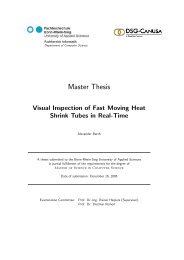Master Thesis - Hochschule Bonn-Rhein-Sieg
Master Thesis - Hochschule Bonn-Rhein-Sieg
Master Thesis - Hochschule Bonn-Rhein-Sieg
You also want an ePaper? Increase the reach of your titles
YUMPU automatically turns print PDFs into web optimized ePapers that Google loves.
6. Evaluating the safety <strong>Master</strong> <strong>Thesis</strong> Björn Ostermann page 102 of 126<br />
Where a control device is designed and constructed to perform several different actions, namely<br />
where there is no one-to-one correspondence, the action to be performed must be clearly<br />
displayed and subject to confirmation, where necessary. […]<br />
� 1.2.3. Starting<br />
It must be possible to start machinery only by voluntary actuation of a control device provided<br />
for the purpose. […]<br />
For machinery functioning in automatic mode, the starting of the machinery, restarting after a<br />
stoppage, or a change in operating conditions may be possible without intervention, provided<br />
this does not lead to a hazardous situation. […]<br />
� 1.3.7. Risks related to moving parts<br />
The moving parts of machinery must be designed and constructed in such a way as to prevent<br />
risks of contact which could lead to accidents or must, where risks persist, be fitted with guards<br />
or protective devices. […] [66]<br />
6.2 Standards<br />
Generally directives all require applying the state of the art. When using so called harmonized<br />
standards, the manufacturer has the consumption of conformity. That means he can assume that he has<br />
fulfilled the essential health and safety requirements, as laid down in the technical annexes of the<br />
directives. In the machinery directive this is formulated in article 2 l.<br />
“Article 2 (l):<br />
‘harmonised standard’ means a non-binding technical specification adopted by a<br />
standardisation body, namely the European Committee for Standardisation (CEN), the<br />
European Committee for Electrotechnical Standardisation (CENELEC) or the European<br />
Telecommunications Standards Institute (ETSI), on the basis of a remit issued by the<br />
Commission in accordance with the procedures laid down in Directive 98/34/EC of the<br />
European Parliament and of the Council of 22 June 1998 laying down a procedure for the<br />
provision of information in the field of technical standards and regulations and of rules on<br />
Information Society services.” [66]<br />
Standards are divided into A, B and C norms, ranging from fundamental safety standards which are<br />
applicable to all machinery (type A) over standards dealing with aspects of safety that can be applied<br />
across a group of machinery (type B) to specific standards, applicable to a specific type of machinery<br />
(type C).<br />
Since the approach given in this project is still under development no type C standard that matches the<br />
complete project exists. Thus, where possible, only type A and B standards can be used. Type C<br />
standards can only be used in parts.<br />
The standards to be considered in a collaborative robot workplace are especially:<br />
Type A:<br />
- EN 12100-1 “Safety of machinery — Basic concepts, general principles for design — Part 1:<br />
Basic terminology, methodology”<br />
This standard covers the complete first part of annex I of the Machinery Directive. Therefore it<br />
covers also the points listed in chapter 6.1.1.<br />
- EN ISO 14121 “Safety of machinery — Risk assessment — Part 1: Principles”














